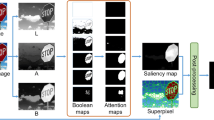Abstract
The goal of salient object detection is to estimate the regions which are most likely to attract human’s visual attention. As an important image preprocessing procedure to reduce the computational complexity, salient object detection is still a challenging problem in computer vision. In this paper, we proposed a salient object detection model by integrating local and global superpixel contrast at multiple scales. Three features are computed to estimate the saliency of superpixel. Two optimization measures are utilized to refine the resulting saliency map. Extensive experiments with the state-of-the-art saliency models on four public datasets demonstrate the effectiveness of the proposed model.
Similar content being viewed by others
References
ITTI L, KOCH C, NIEBUR E. A model of saliencybased visual attention for rapid scene analysis [J]. IEEE Transactions on Pattern Analysis and Machine Intelligence, 1998, 20(11): 1254–1259.
HAREL J, KOCH C, PERONA P. Graph-based visual saliency [C]// Proceedings of Neural Information Processing Systems. Piscataway, NJ: IEEE, 2007: 545–552.
RIGAS I, ECONOMOU G, FOTOPOULOS S. Efficient modeling of visual saliency based on local sparse representation and the use of hamming distance [J]. Computer Vision and Image Understanding, 2015, 134: 33–45.
ZHANG J, WANG M, ZHANG S, et al. Spatiochromatic context modeling for color saliency analysis [J]. IEEE Transactions on Neural Networks and Learning Systems, 2016, 27(6): 1177–1189.
NOURI A, CHARRIER C, LEZORAY O. Multi-scale mesh saliency with local adaptive patches for viewpoint selection [J]. Signal Processing: Image Communication, 2015, 38: 151–166.
LUO W, LI H, LIU G, et al. Global salient information maximization for saliency detection [J]. Signal Processing: Image Communication, 2012, 27(3): 238–248.
WU J, SHEN X, ZHU W, et al. Mesh saliency with global rarity [J]. Graphical Models, 2013, 75(5): 255–264.
XU L, ZENG L, DUAN H. An effective vector model for global-contrast-based saliency detection [J]. Journal of Visual Communication and Image Representation, 2015, 30: 64–74.
YEH H H, LIU K H, CHEN C S. Salient object detection via local saliency estimation and global homogeneity refinement [J]. Pattern Recognition, 2014, 47(4): 1740–1750.
TONG N, LU H, ZHANG Y, et al. Salient object detection via global and local cues [J]. Pattern Recognition, 2015, 48(10): 3258–3267.
FAN Q, QI C. Saliency detection based on global and local short-term sparse representation [J]. Neurocomputing, 2016, 175: 81–89.
ACHANTA R, SHAJI A, SMITH K, et al. SLIC superpixels compared to state-of-the-art superpixel methods [J]. IEEE Transactions on Pattern Analysis and Machine Intelligence, 2012, 34(11): 2274–2282.
HE K, SUN J, TANG X. Single image haze removal using dark channel prior [J]. IEEE Transactions on Pattern Analysis and Machine Intelligence, 2011, 33(12): 2341–2353.
LIU T, YUAN Z, SUN J, et al. Learning to detect a salient object [J]. IEEE Transactions on Pattern Analysis and Machine Intelligence, 2011, 33(2): 353–367.
ALPERT S, GALUN M, BRANDT A, et al. Image segmentation by probabilistic bottom-up aggregation and cue integration [J]. IEEE Transactions on Pattern Analysis and Machine Intelligence, 2012, 34(2): 315–327.
YAN Q, XU L, SHI J, et al. Hierarchical saliency detection [C]// Proceedings of IEEE Conference on Computer Vision and Pattern Recognition. Piscataway, NJ: IEEE, 2013: 1155–1162.
YANG C, ZHANG L. LU H, et al. Saliency detection via graph-based manifold ranking [C]// Proceedings of IEEE Conference on Computer Vision and Pattern Recognition. Piscataway, NJ: IEEE, 2013: 3166-3137.
MURRAY N, VANRELL M, OTAZU X, et al. Saliency estimation using a non-parametric low-level vision model [C]// Proceedings of IEEE Conference on Computer Vision and Pattern Recognition. Piscataway, NJ: IEEE, 2011: 433–440.
HOU X, HAREL J, KOCH C. Image signature: Highlighting sparse salient regions [J]. IEEE Transactions on Pattern Analysis and Machine Intelligence, 2012, 34(1): 194–201.
GOFERMAN S, ZELNIK-MANOR L, TAL A. Context-aware saliency detection [J]. IEEE Transactions on Pattern Analysis and Machine Intelligence, 2012, 34(10): 1915–1926.
SHEN X, WU Y. A unified approach to salient object detection via low rank matrix recovery [C]// Proceedings of IEEE Conference on Computer Vision and Pattern Recognition. Piscataway, NJ: IEEE, 2012: 853–860.
MARGOLIN R, TAL A, ZELNIK-MANOR L. What makes a patch distinct? [C]// Proceedings of IEEE Conference on Computer Vision and Pattern Recognition. Piscataway, NJ: IEEE, 2013: 1139–1146.
ZHU W, LIANG S, WEI Y, et al. Saliency optimization from robust background detection [C]// Proceedings of IEEE Conference on Computer Vision and Pattern Recognition. Piscataway, NJ: IEEE, 2014: 2814–2821.
TONG N, LU H, ZHANG L, et al. Saliency detection with multi-scale superpixels [J]. IEEE Signal Processing Letters, 2014, 21(9): 1035–1039.
TONG N, LU H, RUAN X, et al. Salient object detection via bootstrap learning [C]// Proceedings of IEEE Conference on Computer Vision and Pattern Recognition. Piscataway, NJ: IEEE, 2015: 1884–1892.
Author information
Authors and Affiliations
Corresponding author
Additional information
Foundation item: the Natural Science Foundation of China (Nos. 61602349, 61375053, and 61273225), the China Scholarship Council (No. 201508420248), and Hubei Chengguang Talented Youth Development Foundation (No. 2015B22)
Rights and permissions
About this article
Cite this article
Mu, N., Xu, X., Wang, Y. et al. A multiscale superpixel-level salient object detection model using local-global contrast cue. J. Shanghai Jiaotong Univ. (Sci.) 22, 121–128 (2017). https://doi.org/10.1007/s12204-017-1810-z
Received:
Published:
Issue Date:
DOI: https://doi.org/10.1007/s12204-017-1810-z




